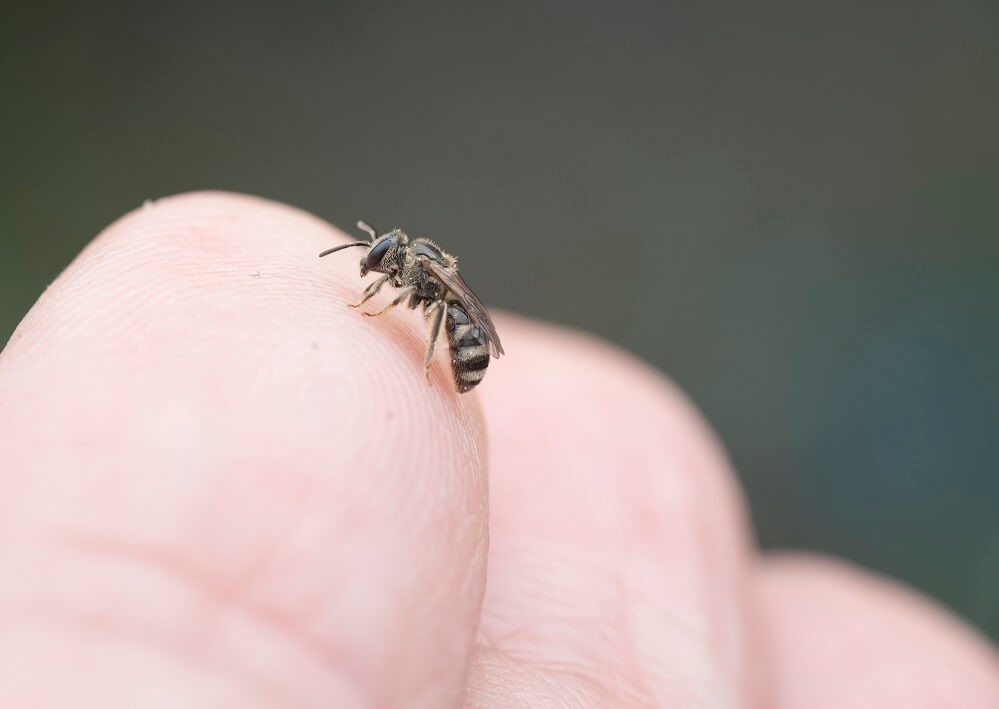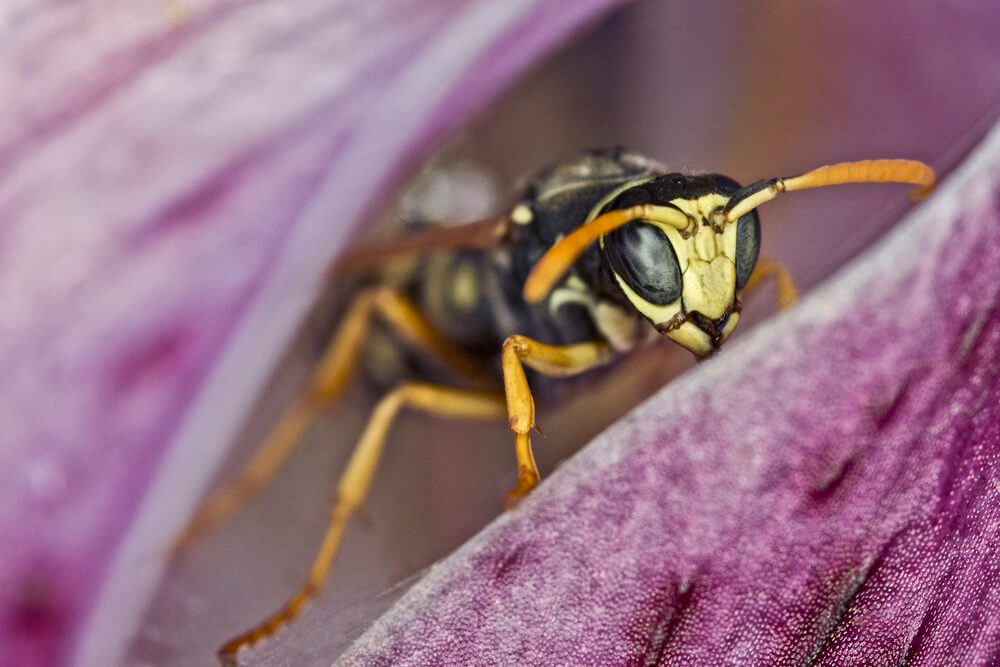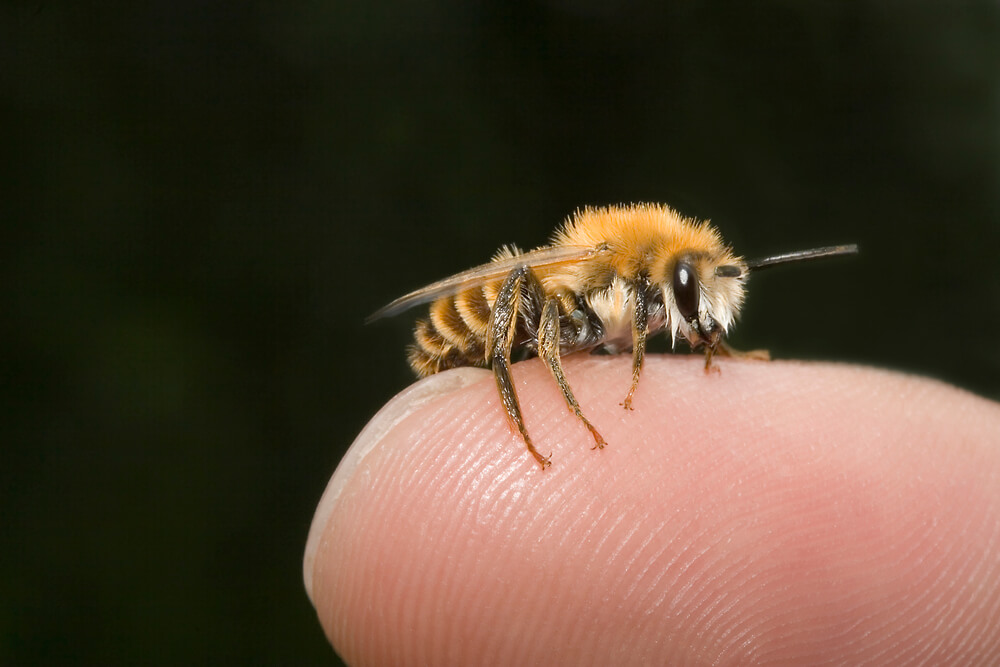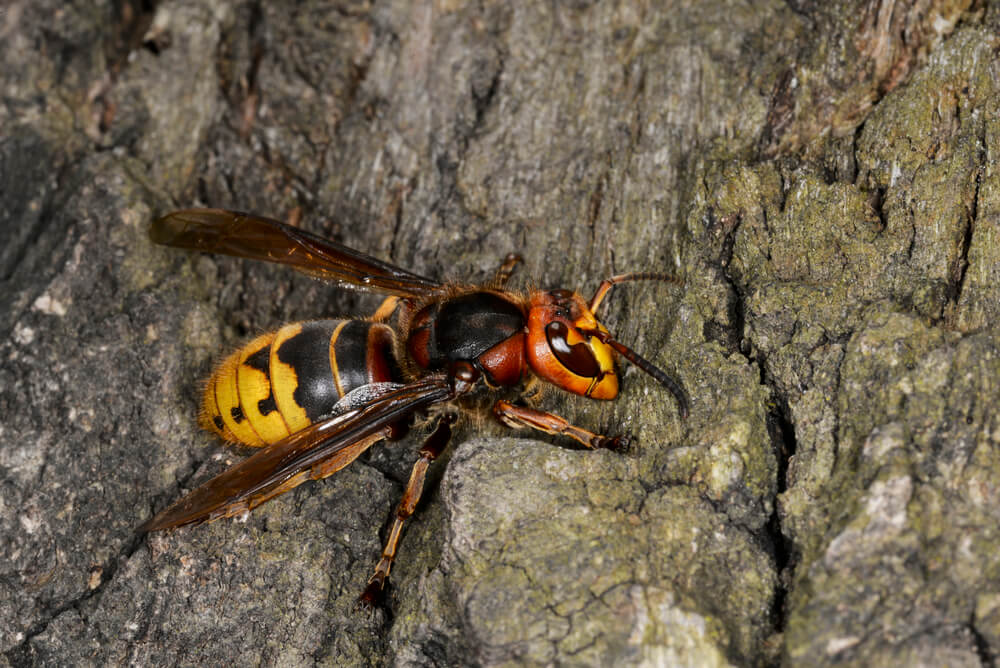Table of Contents:
Do All Bees Sting?
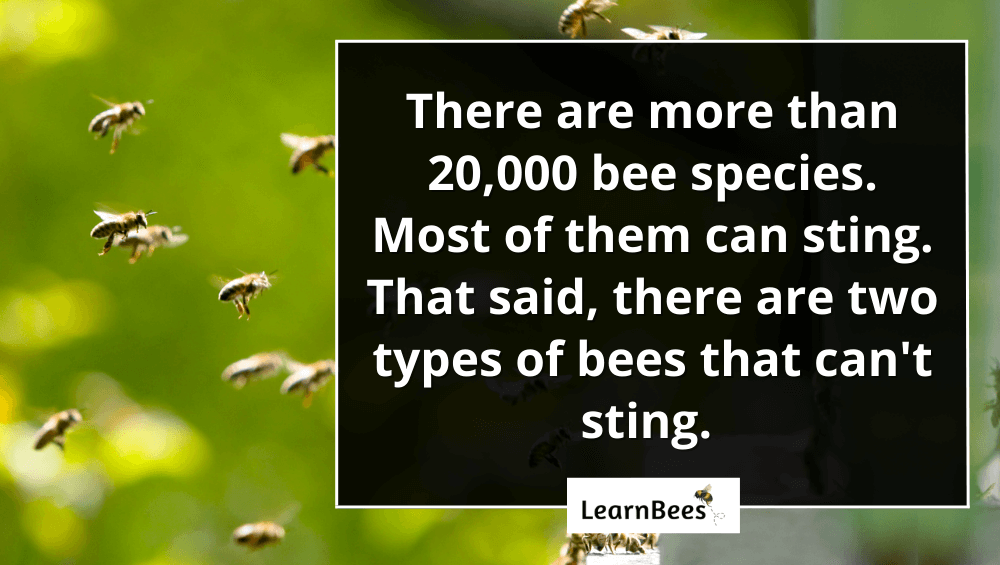
No, there are some types of bees that cannot sting.
Here’s the thing:
There are more than 20,000 species of bees.
For example, well-known bee species include honeybees, bumblebees, and carpenter bees. You’re probably aware that honeybees and bumblebees can sting.
But what about other types of bees?
Great question.
Generally speaking, most types of bees can sting. This is because bees have hundreds – or even thousands – of natural predators to watch out for. Birds, raccoons, bears, and even other insects will eat bees or their honey.
As such, bees need stingers to protect themselves.
Think about it like this:
A bear can take down an entire honeybee hive in a matter of seconds. And when that happens, it’s the honeybees entire life’s work destroyed in the blink of an eye.
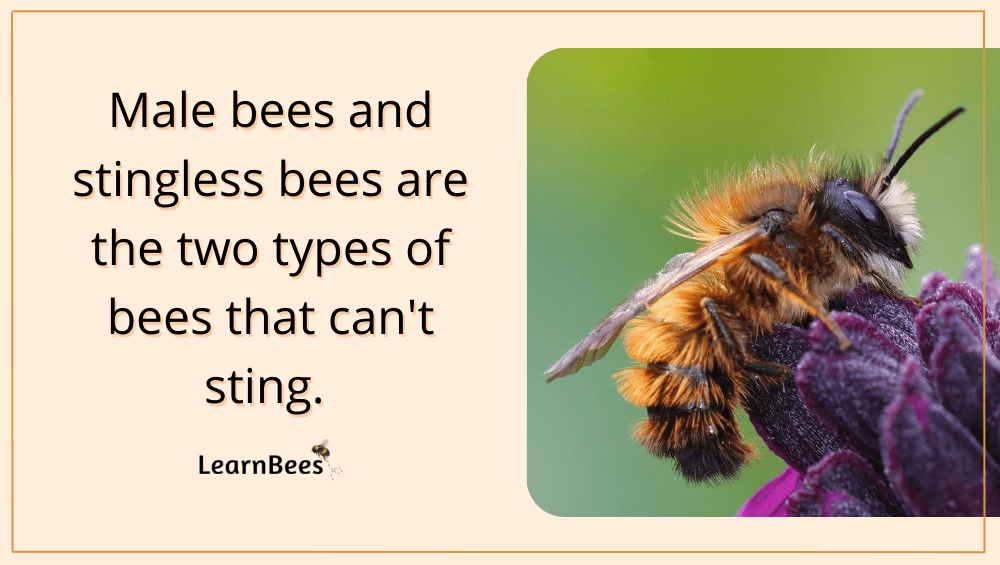
With that in mind: there are two types of bees that don’t sting:
- Male bees
- Stingless bees
Firstly, male bees can’t sting because they don’t have stingers. Stingers are modified egg-laying organs, so only female bees have them.
This is also true for wasps.
Only female wasps are equipped with stingers. Male wasps are not.
This is because male bees and wasps have different roles in the hive. They don’t clean, build, or protect the nest. Their sole job is to mate with females to create the future generation of bees and wasps.
That’s it.
Additionally, there is a category of bees called “stingless bees.” As their name suggests, stingless bees don’t sting. There are around 550 species of stingless bees, and they’re located in tropical climates all over the globe.
Stingless bees are usually smaller than the honeybees we’re used to seeing in the US.
But here’s the kicker:
Female stingless bees do have stingers. But, their stingers are tiny and weak, making them unsuitable for defense.
So that brings us to the big question…
Do Some Bees Bite Instead of Sting?
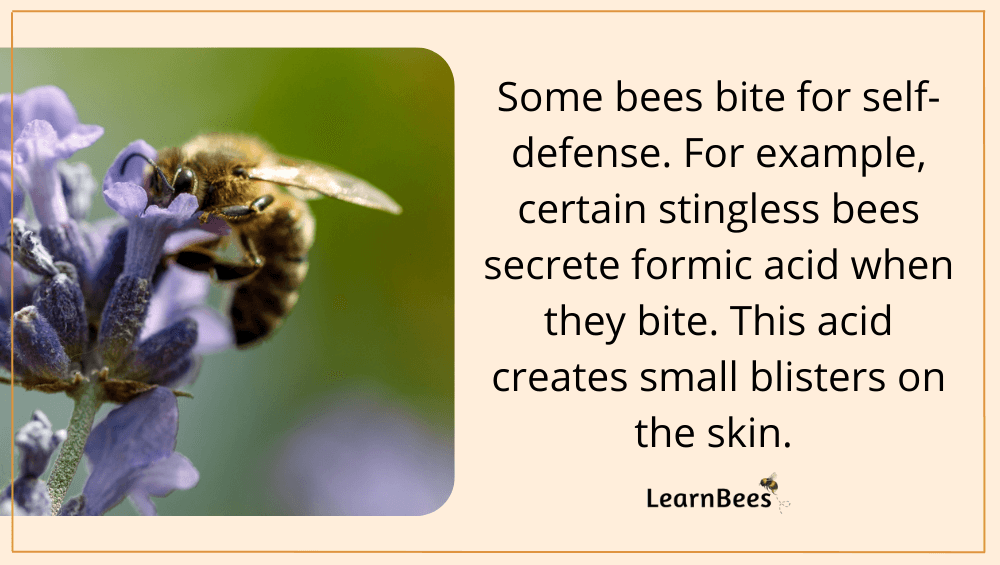
Yes.
As mentioned, stingless bees have useless stingers that are too small to be effective. That said, many stingless bees bite for self-defense.
And here’s the interesting part:
Some stingless bees can release formic acid when biting. This can create blisters similar to the ones you get from ant bites.
But what about male bees?
Since male bees can’t sting, their best defense is to fly away from trouble or rely on the female colony members to protect them. However, that doesn’t mean that male bees are completely useless.
Let’s not forget:
Male bees have one critical role, which is to help create the future generation of male bees.
Do Bees Give Warning Signs Before Stinging?
Yes, bees will often show signs of defensiveness before stinging.
For example, bees might fly at your face or head. Some bees might even do a “dive bomb” technique where they come out of nowhere and bump you.
Here’s a video of a bumblebee displaying “back off” warning signs when threatened:
Notice how the bumblebee behaved?
When threatened, she raised her legs and began pointing her stinger towards the man’s finger. She was displaying clear warning signs that she was about to sting.
FAQs on “Do All Bees Sting?”
- Do all female bees sting?
- Do all male bees not sting?
- Which bee is least likely to sting you?
- How long will bees chase you in order to sting?
- What happens if the queen bee stings you?
- Is there a bee that does not sting?
- Do bees give warning stings?
- Do only female bees have stingers?
- Are bees friendly?
- Do some bees bite instead of sting?
- Are there little yellow bees that don’t sting?
- Do all bumblebee species sting?
- Do all honeybee species sting?
- Do solitary bees sting?
Do all female bees sting?
No, some female bees – such as stingless bees – don’t sting. Instead, they bite predators as a means of defense. Their bite releases formic acid, leading to blisters similar to ant bites.
But remember:
Most bees can sting as a means of defending themselves or their hive. This is because bees have numerous predators, including wasps, hornets, and even some birds. As such, bees have to be prepared to handle these threats.
—> Go back to the FAQs on “Do All Bees Sting?”
More to Explore:
- What Does a Bee Sting Look like?
- Do Bees Die When They Sting?
- The Best Essential Oils for Bee Stings
Do all male bees not sting?
That’s correct. Male bees – also called drones – don’t have stingers. This is because their role in the hive is simply to mate with female bees. They don’t have other responsibilities, such as cleaning, building, or protecting the hive.
Also, remember:
Stingers are modified egg-laying organs. Since male bees don’t lay eggs, they don’t need stingers.
—> Go back to the FAQs on “Do All Bees Sting?”
More to Explore:
Which bee is least likely to sting you?
You might be surprised to learn that most bees are passive creatures that don’t go out of their way to sting people.
Let’s face it.
Bees get a bad rap because of their stingers. Some people are fearful that if they get too close to a bee on a flower, the bee will turn around and sting them.
This simply isn’t true.
Bees are mostly only protective when it comes to their nests. You typically have very little to worry about if you see a bee buzzing around flowers. They’re away from their hives and aren’t in “defense” mode.
With that in mind, solitary bees like mason bees are probably the least likely to sting humans.
This is because solitary bees live alone and don’t produce honey. As such, they aren’t as territorial as honeybees are.
So, in a nutshell, bees that live in hives (like honeybees and bumblebees) are more likely to sting than solitary bees. However, honeybees and bumblebees are mostly gentle creatures that will leave you alone if you don’t go poking around their hives.
The exception is Africanized honeybees.
Africanized honeybees are a hybrid of the European honeybee and the African honeybee. They were first introduced to Brazil in the 1950s to boost honey production.
However, these bees quickly spread throughout South America and eventually made their way into the southern United States.
Africanized honeybees are much more aggressive than other types of honeybees. They’re also more likely to attack humans and animals that come too close to their nests.
—> Go back to the FAQs on “Do All Bees Sting?”
More to Explore:
- Do Carpenter Bees Sting?
- How to Remove a Bee Stinger Stuck Under Skin
- The 10 Best Flowering Trees for Bees
How long will bees chase you in order to sting?
In my experience, a bee won’t follow you more than 20 feet away from its hive. After giving them enough space, they’ll stop following you and return home.
This doesn’t apply to Africanized honeybees.
As mentioned, Africanized honeybees are more defensive and aggressive than other honeybees. They’re found in Texas, Nevada, Arizona, Louisiana, New Mexico, Oklahoma, and Florida.
If you come too close to their nests, they may chase you for up to a quarter-mile which is 1,320 feet.
So the best thing to do is be aware of your surroundings. If you’re in an area where Africanized honeybees are known to live, be extra careful not to disturb any hives.
—> Go back to the FAQs on “Do All Bees Sting?”
More to Explore:
What happens if the queen bee stings you?
In most cases, a single bee sting isn’t the end of the world. You’ll experience a sharp pain followed by slight swelling and redness at the sting site. Over the next 24 hours, the redness and irritation should disappear.
The only cause for concern would be if you’re seriously allergic to bee stings or if you’ve been stung dozens of times.
In these cases, you may experience anaphylactic shock, which is a potentially life-threatening reaction.
If you have a known allergy to bee stings, make sure to carry an EpiPen with you at all times.
As for the queen honeybee, her sting is no different from that of a worker bee. The only difference is that she can sting multiple times since she doesn’t lose her stinger when she stings.
With that said, it’s very rare to get stung by a queen honeybee because she stays inside the hive where the worker bees protect her.
—> Go back to the FAQs on “Do All Bees Sting?”
More to Explore:
Is there a bee that does not sting?
“Do all bees have stingers?” and “Do all bee types sting?” are common questions we get.
The answer is that not all bees sting. In fact, male bees can’t sting at all. This is because a bee’s stinger is actually a modified egg-laying device. Since male bees don’t lay eggs, they don’t have stingers.
Also, stingless bees can’t sting either. These bees are found in tropical climates like Australia.
—> Go back to the FAQs on “Do All Bees Sting?”
More to Explore:
Do bees give warning stings?
Yes, bees give warning stings to tell you to back away from them or their hives. If you don’t give them enough space, it could encourage a swarm of bees to start stinging you.
It’s smart to heed their warning and give them the necessary space. If you’re seriously allergic to bee stings, a single sting could be enough to send you into anaphylactic shock.
—> Go back to the FAQs on “Do All Bees Sting?”
More to Explore:
Do only female bees have stingers?
Only female bees have stingers. Male bees don’t have stingers because they can’t lay eggs. Remember that stingers are modified egg-laying devices.
—> Go back to the FAQs on “Do All Bees Sting?”
More to Explore:
- Ground Bees: Are They a Threat to Your Yard?
- Wasps vs. Honeybees: Are They Different?
- Do Bumble Bees Bite?
Are bees friendly?
Most bees are friendly creatures that will only sting you if they feel threatened. In most cases, you shouldn’t feel threatened by bees pollinating flowers. They’ll ignore you if you don’t try to touch or grab them.
Additionally, bees are friendly to other species of bees and animals. For example, it’s not uncommon to see bees buzzing around flowers with butterflies, wasps, and hummingbirds. They can coexist peacefully.
Africanized honeybees are the exception to this rule. They’re much more aggressive and will attack humans and animals that come too close to their nests. But again, this is if you get too close to their hive. They aren’t as aggressive when they’re away from their nest.
—> Go back to the FAQs on “Do All Bees Sting?”
More to Explore:
- Do Carpenter Bees Pollinate?
- How Long Do Bumble Bees Live?
- Honeybees vs. Bumblebees: How Do They Compare?
Do some bees bite instead of sting?
Some bees do bite instead of sting.
For example, some stingless bees will bite you if you come too close to their hive. However, this is more of a defense mechanism than anything else. They don’t go around biting people for no reason. They simply have no other method of protecting themselves.
—> Go back to the FAQs on “Do All Bees Sting?”
More to Explore:
Are there little yellow bees that don’t sting?
This is a common question; however, it’s hard to answer specifically without knowing the bee species you’re referring to. There are many bee species in many sizes, shapes, and colors, so “little yellow bee” is vague.
—> Go back to the FAQs on “Do All Bees Sting?”
More to Explore:
Do all bumblebee species sting?
To my knowledge, all species of bumblebees sting. There are over 250 species of bumblebees.
However, only the female bumblebees can sting. Male bumblebees don’t have stingers because they can’t lay eggs. Stingers are modified egg-laying devices.
But keep in mind:
Bumblebees are relatively docile creatures that will only sting you if they feel threatened. So, unless you’re trying to harm them or their hive, you shouldn’t have anything to worry about.
—> Go back to the FAQs on “Do All Bees Sting?”
More to Explore:
Do all honeybee species sting?
To our knowledge, all species of honeybees sting.
Again, only the female honeybees can sting. Male honeybees don’t have stingers because they can’t lay eggs. Stingers are modified egg-laying devices.
European honeybees are actually pretty docile creatures. They’ll only sting you if they feel like you’re going to harm them or harm their hive. So, you shouldn’t be too concerned unless you’re trying to hurt them or their nest.
—> Go back to the FAQs on “Do All Bees Sting?”
More to Explore:
- What’s the Difference Between Wasps, Hornets, and Bees?
- Bee Antennae: Interesting Facts & Uses
- What Are Green Bees?
Do solitary bees sting?
Yes, solitary bees can sting. However, getting a sting from a solitary bee is very rare. Mason bees, carpenter bees, and leafcutter bees are examples of solitary bees. Since they don’t have a hive or honey, they’re naturally less territorial than honeybees.
That being said, if you try to hurt or disturb their nests, they may sting you in self-defense. But again, this is rare.
—> Go back to the FAQs on “Do All Bees Sting?”
